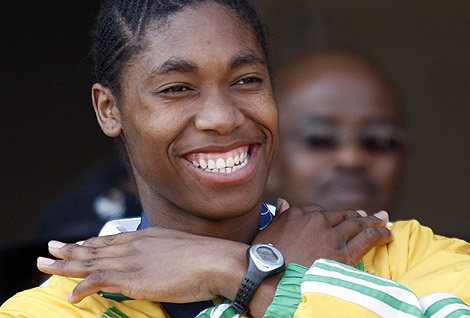Caster Semenya: Has she met her Kryptonite?
The damage had been done.
Whether through insensitivity, ignorance, or just plain incompetence, an athlete was victimized in one of sport’s most embarrassing atrocities.
South African 800-meter world champion Caster Semenya was publicly stripped (of her dignity), raped (of her privacy), and disemboweled (of her physiology) by medical experts, governing sports entities, and news media.
Semenya was effectively banned from competition after her stunning 2009 victory in Berlin’s World Championships. Her rapid week-to-week improvement and her impressive world-leading time in the finals (1:55.45) prompted an intrusive gender verification process which left no piece of the champion’s persona hidden.
During the eleven-month ordeal, the black cloud of suspicion and controversy which fell first on Semenya, suddenly moved to cast its shadow on the various governing powers whose charge it was to protect the athlete.
Still, the damage had been done.
But as it is said, “…every dark cloud has its silver lining.”
Yes, after an excruciating delay, Semenya was finally cleared by Track and Field’s governing body (IAAF) to compete as a woman.
But the real silver lining is this: After such brutal treatment, the victim actually survived—and somehow was able to quickly put the trauma behind her, renewing a personal quest which only days before seemed all but dead.
Which tells me something about one of the few organs in Semenya’s anatomy which has not been probed and scrutinized—her champion’s heart. But more on that in a moment.
In spite of the IAAF’s vow of silence on the matter, one of the world’s worst-kept secrets has leaked out: Semenya is receiving hormone treatment which basically reduces her natural testosterone levels while increasing her estrogen levels.
The monitoring of these levels will insure that Semenya is performing within the acceptable limits established for women’s competition.
From the perspective of the rest of the sporting world, where a level playing field is the common denominator, this is only fair and equitable.
From Semenya’s perspective, who has always identified as a woman, it may seem as if she has been tethered to a 10-pound handicap—which she is willing to accept.

Science tells us that because of the treatments, we will begin to see a less masculine and more feminine Caster. The treatments will also make it more difficult for Semenya to obtain those world-class times which only last year came with such seeming ease.
Hormones then, will most certainly affect Semenya’s performance in both training and competition. But can they affect the more intangible and immeasurable virtues of fortitude and grit?
This is where the aforementioned issues of heart come into play. Can Semenya’s inner drive compensate for the increased physical challenge?
Perhaps the fiery trials of the past eleven months have ironically served to only harden the steely champion.
Michael Seme, Semenya’s coach, has wisely plotted a gradual and discreet return to the track. In two meets in Finland, his charge produced two respectable wins against modest competition, 2:04.22 and 2:02.41, with less-than-peak conditioning.
Given Semenya’s late-season start, she may be one of the few athletes with something left in the tank at Delhi’s Commonwealth Games in October. There, we will have the year’s best marker as to Semenya’s progress in returning to world championship form.
Still only 19, the South African has several World Championships and possibly three Olympics ahead to make her case: Can a scaled-back version of Caster Semenya still provide the same gusto and kick as the original?
The spirit may be willing. Will the flesh be weak?
Rojofact: The world record in the women’s outdoor 800m is 1:53.28 set in 1983 by Czechoslovakia’s Jarmila Kratochvilova. The 2010 world-best (as of this writing) is 1:57.56 by Russia’s Mariya Savinova.
Rojothought: In reading my final draft, two questions came to mind. 1) How were the legal hormonal limits in women’s competition derived? 2) If these limits are known, what will prevent other women from pushing their testosterone levels to the very edge of legality? Hmmm…
photos: AP










